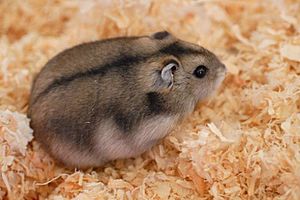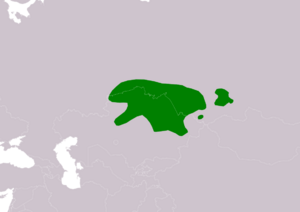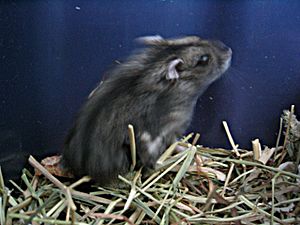Winter white dwarf hamster facts for kids
Quick facts for kids Winter white dwarf hamster |
|
|---|---|
 |
|
| Conservation status | |
| Scientific classification | |
| Genus: |
Phodopus
|
| Species: |
sungorus
|
 |
|
| Range of P. sungorus Resident | |
The winter white dwarf hamster (Phodopus sungorus), also known as the Russian dwarf hamster, is a small, round hamster. It is one of three types of hamsters in the Phodopus group. These hamsters are about half the size of a Syrian hamster, which is why they are called dwarf hamsters.
Winter white hamsters have a thick, dark grey stripe on their back and furry feet. As winter gets closer and days become shorter, their dark fur almost completely turns white. This helps them blend in with snow in the wild. If they are kept as pets indoors, this fur change usually does not happen. This is because artificial lights prevent them from noticing the shorter winter days. In the wild, they live in wheat fields in Kazakhstan, meadows in Mongolia and Siberia, and birch forests in Manchuria.
Winter white dwarf hamsters are popular pets in Europe and North America. Their fur colors can vary more than those found in the wild. They reproduce often and can have babies all year round. Young hamsters might act a bit rough with each other. Female hamsters that are having babies can also be aggressive towards males. The winter white hamster is known for being one of the easiest types of hamsters to tame.
Contents
Naming the Hamster
This hamster does not have one official common name. Winter white dwarf hamster and Russian dwarf hamster are used most often. Sometimes, people get them mixed up with Campbell's dwarf hamster because they look similar. So, names like Djungarian hamster or Russian dwarf can sometimes mean both types.
The name "winter white" comes from how the hamster's fur changes to white in the wild during winter. This helps the hamster hide from animals that hunt them when there is snow on the ground. Campbell's dwarf hamsters do not change their fur color in winter. So, calling them "winter white" would be wrong.
The scientific name for this hamster is Phodopus sungorus. A scientist named Peter Simon Pallas first described the hamster in 1773. He first thought it was a type of mouse. The name sungorus comes from a place called Dzungaria.
Physical Description
The fur of the winter white dwarf hamster is not as fluffy as the Campbell's dwarf hamster. Besides the usual grey color, they can also be sapphire, sapphire pearl, or normal pearl.
These hamsters are usually 70–90 mm (about 3 inches) long from head to body. Their tails are very short, about 5–15 mm. Their back legs are 11–15 mm long. Their body weight changes a lot during the year. It is lowest in winter. Wild males weigh from 19 to 45 g, and females from 19 to 36 g. Pet hamsters are usually a bit heavier.
In captivity, winter white dwarf hamsters usually live for one to three years. Some can live longer. In the wild, they might only live for about one year.
Fur Color Changes
In summer, the fur on their back changes from ash-grey to dark brown. Sometimes it can be pale brown. Their face turns grey or brown. The area around their mouth, whiskers, and ears is a bit brighter. The outer ears and eyes have black edges. A black-brown stripe runs from their head to their tail. Their throat, belly, tail, and legs are white.
In winter, their fur becomes thicker. More than 10% of pet hamsters might not change to their winter coat in their first winter. In the second winter, even fewer change color, and the winter color is less clear. The change to winter fur starts in October or November and finishes by December. The change back to summer fur begins in January or February and finishes by March or early April.
The color of their hair is controlled by a hormone called prolactin and their genetics. Short days (less than 14 hours of light) can make them change to their winter coat. This change can even happen in summer if the days are made shorter. They change back to their summer coat in autumn when the day length changes again.
In the Wild

In the wild, the hamster's fur changes color in winter. This helps them hide from animals that hunt them in the snowy steppes. Hamsters dig tunnels up to one meter deep. These tunnels lead to burrows where they sleep, raise their young, and hide from predators. The weasel is one of their main predators. Most of these burrows have six entrances.
In summer, they line their burrows with moss. To keep warm in winter, they close all but one entrance. They also line their burrows with animal fur or wool they find. The temperature inside the burrow is usually about 16.7 °C (62 °F).
These hamsters sometimes live in semideserts in Central Asia. They also live in dry steppes and fields of wheat or alfalfa. They can be found in small fields within forests around Minusinsk. The fur on their feet protects them from the cold ground in their chilly homes.
Pet Ownership
Winter white hamsters are popular pets in Europe, Japan, and North America. Taking care of them is similar to other Phodopus hamsters. Like most rodents, hamsters can get tumours. They can also hurt their cheek pouch if sharp objects damage the inside. Other health issues can include bite wounds, broken teeth, constipation, dehydration, diarrhea, and ear problems. They might need extra protein sometimes.
Reproduction and Life Cycle
Winter white dwarf hamsters reproduce faster than Syrian hamsters. Phodopus hamsters can get pregnant again on the same day they give birth. This can all happen within 36 days. This is a way for them to have many babies quickly to survive. This puts a lot of demands on the mother.
Young hamsters might fight often. As soon as they stop drinking milk from their mother, they are separated from her. Most dwarf hamsters grow to be about 3 to 4 inches long. Hamsters kept indoors with artificial light during autumn and winter might breed all year. In the wild, or if kept under natural light, they only breed in spring and summer.
During breeding time, hamsters can become aggressive. After mating, the female might try to attack the male to protect her babies. The male usually hides in holes or caves to escape. The female hamster's estrous cycle lasts four days. Every four days, she might accept the male again to breed. This usually happens when it gets dark in the evening.
Hybrids
Of the five types of hamsters commonly kept as pets, only Campbell's dwarf hamster and the winter white dwarf hamster can breed together. They can produce live baby hamsters that are a mix of both types, called hybrids.
Even though hybrids can make good pets, breeding them can cause health problems and issues with having babies. Also, if many hybrids are bred and spread around, it could threaten the pure types of both species. This could lead to only mixed hamsters existing. Breeding hybrids can also make each group of babies smaller. The young hamsters might also start to have problems from birth.
Conservation Status
The International Union for Conservation of Nature (IUCN) lists this hamster as of Least Concern. This means its population and where it lives are large. There are no big or widespread threats known for this species. The exact number of hamsters in the wild is not recorded.





